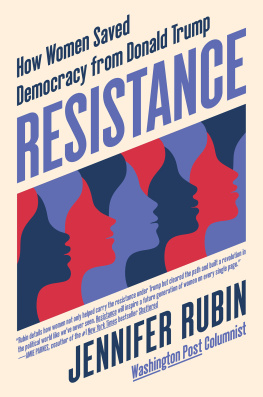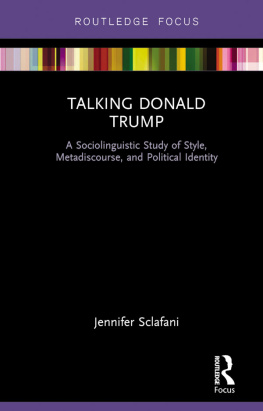Contents
For democracys defenders
I stand on their shoulders. Others stand on mine. I know my responsibility.
Nancy Pelosi on the suffragettes, from her 2019 Time 100 interview
Women belong in all places where decisions are being made.... It shouldnt be that women are the exception.
Associate Supreme Court Justice Ruth Bader Ginsburg on the elevation of Sonia Sotomayor
Especially for women, Donald J. Trumps 2016 election came as a bolt out of the blue, a jolt that left them personally wounded, fearful, and angry. They had expected so much better from the American electorate. Demagogues had run for president before but had been kept at bay. Huey Long, George Wallace, and Father Coughlin never came close to winning national elections. Nevertheless, tens of millions of voters had embraced an abjectly ignorant, racist, and unfit huckster. His negative attributes had not disqualified him in their eyes but rather they endeared him to them.
His election unnerved the daughters of the 1960s and 1970s, who had seen uneven but forward progress for women on so many fronts. The election of a man nostalgic for the unliberated 1950s undermined their faith in their fellow Americans judgment and tolerance. The assumption that one could rely on the common sense of the American people now seemed farcical. Past gains women had once imagined permanent, such as access to safe abortions, seemed suddenly fragile. Womens confidence that legal, social, and economic advances provided a floor below which American women could not fall was called into question. The promise that women were on a path to full inclusion and equal power in all aspects of American life? That suddenly seemed like a pipe dream. In the face of this calamity, women did what they always do: They gathered to talk and commiserate, to bolster one another, to share their stories, and to begin planning. With remarkable speed, a grassroots resistance, not made exclusively but certainly primarily of women, began to sprout.
When the shock of election night wore off, millions of women faced daunting challenges: to actively engage as citizens; to elevate womens place in American politics; to continue to fight against Trumps policies; and to decry his outrages, scandals, and lies. Women exasperated by Trumps election ran for office by the hundreds. Others volunteered, raised money, or protested. In whatever role they played over the next four yearsvolunteer, activist, candidate, donor, protesterwomen refused to allow Trumps presidency to become the new normal.
At the same time the grassroots opposition was sprouting, key women power players in the Democratic Party started to pick up the pieces after a devastating loss, infuse their organizations with new purpose, harness the energy from the grassroots, and deploy their fundraising dollars and expertise to dislodge Trump. They channeled womens anger over the confirmation of Justice Brett Kavanaugh in 2018; their outrage over southern states abortion bans; their horror over the grotesque mistreatment of migrant families and children; their indignation over the constant assaults on democracy; and their grief over the passing of Supreme Court Justice Ruth Bader Ginsburg in 2020 into a defiant movement to deny Trump a second term.
Meanwhile, in some corners of the Republican Party, lifelong conservatives were mortified that the party of Abraham Lincoln had united behind someone whose character and views represented a repudiation of everything that had attracted them to the GOP. To the shock of anti-Trump Republicans, fellow members who had once extolled the GOP as the party of ideas countenanced Trumps hostile takeover of the party and, worse, began to rationalize and defend his noxious views. Many craved access to Trumps administration and sought jobs in an executive branch led by a dangerous narcissist.
While the Republican Party devolved into a cult of personality, millions of American women, both Democrats and Republicans, aghast at the 2016 election results, set out on a personal and political journey that began even before the Womens March on January 21, 2017, the largest single day of protest in American history. Democratic women not only ran but triumphed in the 2018 midterm House races. Republican women did the same in 2020. Women candidates joined the presidential race, battling persistent media bias and gender stereotypes, and confronted many less qualified men on the debate stages. Hillary Clinton had not been the last woman to compete for the presidency but the first for a major party. Her losing candidacy benefited the more politically adept and diverse women candidates who followed herand enabled the election of a barrier-breaking woman vice president in 2020.
The Trump era was a time of a personal triumph and political awakening for many women and the birth of a mass movement largely headed and fueled by women. It scrambled many womens assumptions about people on the other end of the political spectrum, forged new friendships, and encouraged the formation of new networks. Women reinvigorated the Democratic Party and threw the Republican Party back on its heels. The political storm that gained steam over four years proved as powerful as the womens movement of the 1970s and as consequential as the 1960s civil rights movement.
Trumps shocking victory provoked millions of women to elevate the importance of politics in their daily livesto the extreme detriment of the party Trump took over. Womens political involvement soared, and their partisan identification shifted in dramatic ways, affecting the composition of Congress, the makeup of the parties, and the language of politics. Ironically, Trump prompted many White women to prioritize gender over race. His election added impetus to political organizing among Black women, long the backbone of the Democratic Party, and among Native Americans.
In the aftermath of Trumps defeat, we can now fully appreciate how millions of women transformed their own lives and recaptured our democracy from the clutches of an authoritarian bully. Defeat is an orphan, the saying goes, but victory in this case had millions of mothers. Their story is what follows.
Part One
From Dejection to Elation
Chapter 1
The Nightmare Begins
The New York Times needle, an omnipresent election tracking device on the Times website, drifted away from Hillary Clinton in the direction of real estate mogul and reality TV star Donald Trump. Gosh how strange. Perhaps the exit polling was out of whack or big metropolitan counties with Democratic voters had not checked in. Sitting in the Washington Posts offices, I felt a sense of panic begin to rise.
By early evening on election night 2016 Trump had won Florida andwhat?!Michigan and Pennsylvania were too close to call. The needle fell farther into the red. Eighty-one percent probability of a Clinton win became 40, then 20. My first reaction, akin to the news of a natural disaster or grave illness in the family, was denial. It cannot be. We all saw Trump on the Access Hollywood video bragging about sexually assaulting women. America could not elect this man. The needle must be wrong. If only.
When I left the Washington Posts offices on K Street just after ten p.m. the DC streets were empty and oddly quiet. Waking up the next morning, I momentarily grasped at the notion that it had been a horrible nightmareor a news reporting screwup that put the Florida 2000 vote-counting debacle to shame. I had written a column breaking up with the Republican Party in the spring of 2016 and then poured my energy into my Washington Post opinion pieces and TV appearances to alert my fellow Americans of the dangers of electing Trump. The irony did not escape me that in the one presidential election in which I was rooting for the Democratic presidential nominee, the party blew what seemed to me and millions of other voters to be an entirely winnable race.








